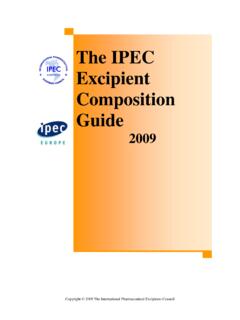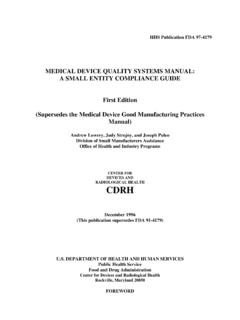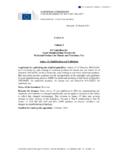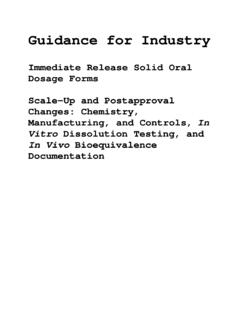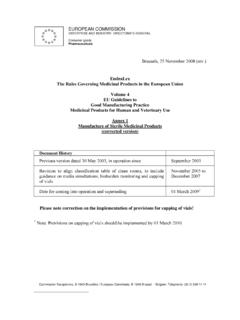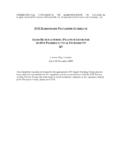Transcription of 2005 12 14 Annex 19 Final - GMP Training, GMP Guidelines ...
1 EUROPEAN COMMISSION. ENTERPRISE AND INDUSTRY DIRECTORATE-GENERAL. Consumer goods Pharmaceuticals Brussels, 14 December 2005. EudraLex The Rules Governing Medicinal Products in the European Union Volume 4. EU Guidelines to good manufacturing Practice Medicinal Products for Human and Veterinary Use Annex 19. Reference and Retention Samples Document History Date for new Annex coming into operation 01 June 2006. Commission europ enne, B-1049 Bruxelles / Europese Commissie, B-1049 Brussel - Belgium. Telephone: (32-2) 299 11 11. 1. Scope This Annex to the guide to good manufacturing Practice for Medicinal Products ( the GMP.)
2 guide ) gives guidance on the taking and holding of reference samples of starting materials, packag- ing materials or finished products and retention samples of finished products. Specific requirements for investigational medicinal products are given in Annex 13 to the guide . This Annex also includes guidance on the taking of retention samples for parallel imported/. distributed medicinal products. 2. Principle Samples are retained to fulfil two purposes; firstly to provide a sample for analytical testing and secondly to provide a specimen of the fully finished product. Samples may therefore fall into two categories: Reference sample: a sample of a batch of starting material, packaging material or finished product which is stored for the purpose of being analysed should the need arise during the shelf life of the batch concerned.
3 Where stability permits, reference samples from critical intermediate stages ( those requiring analytical testing and release) or intermediates, that are transported outside of the manufacturer's control, should be kept. Retention sample: a sample of a fully packaged unit from a batch of finished product. It is stored for identification purposes. For example, presentation, packaging, labelling, patient information leaflet, batch number, expiry date should the need arise during the shelf life of the batch concerned. There may be exceptional circumstances where this requirement can be met without retention of duplicate samples where small amounts of a batch are packaged for different markets or in the production of very expensive medicinal products.
4 For finished products, in many instances the reference and retention samples will be presented identi- cally, as fully packaged units. In such circumstances, reference and retention samples may be re- garded as interchangeable. It is necessary for the manufacturer, importer or site of batch release, as specified under sec- tion 7 and 8, to keep reference and/or retention samples from each batch of finished product and, for the manufacturer to keep a reference sample from a batch of starting material (subject to certain excep- tions see below) and/or intermediate product. Each packaging site should keep reference samples of each batch of primary and printed packaging materials.
5 Availability of printed materials as part of the reference and/or retention sample of the finished product can be accepted. The reference and/or retention samples serve as a record of the batch of finished product or starting material and can be assessed in the event of, for example, a dosage form quality complaint, a query relating to compliance with the marketing authorisation, a labelling/packaging query or a phar- macovigilance report. Records of traceability of samples should be maintained and be available for review by com- petent authorities. 3. Duration of Storage Reference and retention samples from each batch of finished product should be retained for at least one year after the expiry date.
6 The reference sample should be contained in its finished primary 2. packaging or in packaging composed of the same material as the primary container in which the prod- uct is marketed (for veterinary medicinal products other than immunologicals, see also Annex 4, para- graphs 8 & 9). Unless a longer period is required under the law of the Member State of manufacture, samples of starting materials (other than solvents, gases or water used in the manufacturing process) shall be retained for at least two years after the release of product. That period may be shortened if the period of stability of the material, as indicated in the relevant specification, is shorter.
7 Packaging materials should be retained for the duration of the shelf life of the finished product concerned. 4. Size of Reference and Retention Samples The reference sample should be of sufficient size to permit the carrying out, on, at least, two occasions, of the full analytical controls on the batch in accordance with the Marketing Authorisation File which has been assessed and approved by the relevant Competent Authority / Authorities. Where it is necessary to do so, unopened packs should be used when carrying out each set of analytical con- trols. Any proposed exception to this should be justified to, and agreed with, the relevant competent authority.
8 Where applicable, national requirements relating to the size of reference samples and, if nec- essary, retention samples, should be followed. Reference samples should be representative of the batch of starting material, intermediate product or finished product from which they are taken. Other samples may also be taken to monitor the most stressed part of a process ( beginning or end of a process). Where a batch is packaged in two, or more, distinct packaging operations, at least one retention sample should be taken from each individual packaging operation. Any proposed exception to this should be justified to, and agreed with, the relevant competent authority.
9 It should be ensured that all necessary analytical materials and equipment are still available, or are readily obtainable, in order to carry out all tests given in the specification until one year after ex- piry of the last batch manufactured. 5. Storage Conditions Storage of reference samples of finished products and active substances should be in accor- dance with the current version of the Note for Guidance on Declaration of Storage Conditions for Me- dicinal Products and Active Substances. Storage conditions should be in accordance with the marketing authorisation ( refriger- ated storage where relevant).
10 6. Written Agreements Where the marketing authorisation holder is not the same legal entity as the site(s) responsible for batch release within the EEA, the responsibility for taking and storage of reference/retention sam- ples should be defined in a written agreement between the two parties in accordance with Chapter 7 of the EC guide to good manufacturing Practice. This applies also where any manufacturing or batch release activity is carried out at a site other than that with overall responsibility for the batch on the EEA market and the arrangements between each different site for the taking and keeping of reference and retention samples should be defined in a written agreement.

